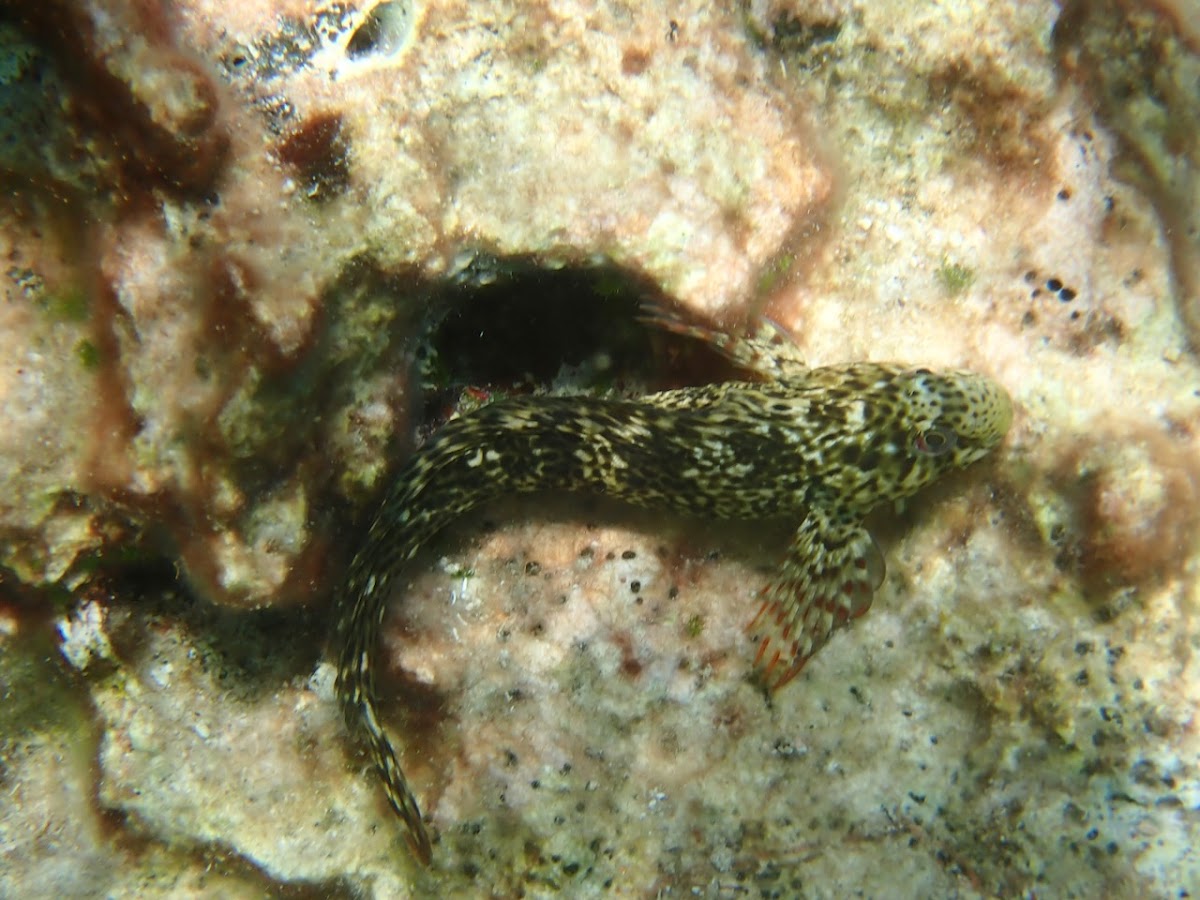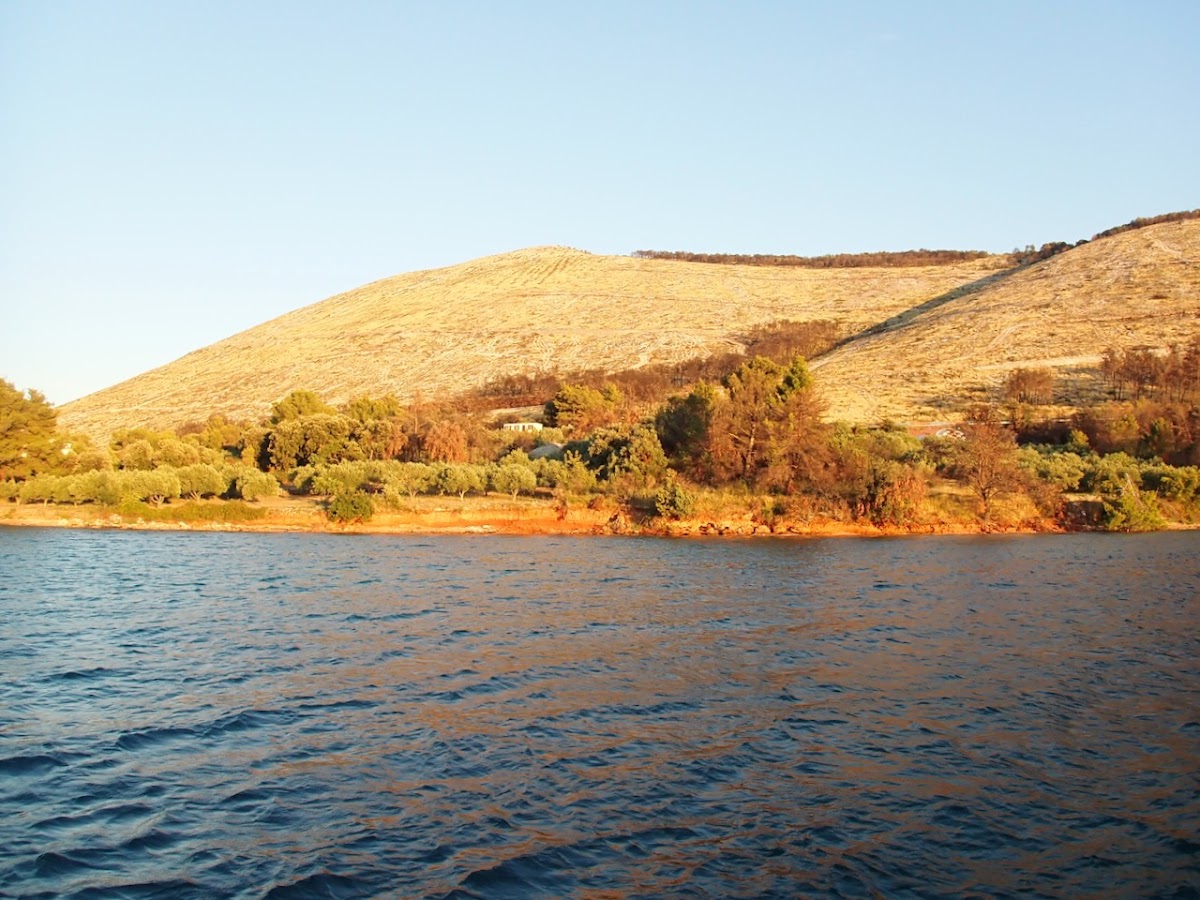After snorkelling on Saturday we sailed to island of Čiovo to bay Račetinovac. Maybe because it was Saturday or because it is close to towns Trogir and Split or because it is well protected from South wind that was forecast, this was the first time we had some dozen of boats around us. On previous nights we were quite surprised how few boats were left in anchorages after small motor boats left in the evening. Not something we expected in high season, but not that we were complaining. When we arrived to the anchorage it was already too late for snorkelling. After dinner our friends and Captain dinghied to Trogir, and they reported that it was very hot and super crowded. Night was calm, but warmer than those before.
Next day it was time to slowly turn back North. We first sailed to island of Drvenik mali and made a stop for lunch and a swim. Weather was cloudy and we even had a bit of rain, so I again didn't go snorkelling. Then we sailed back to bay Mali Trogir. This time there were plenty of boats there, as this bay offers good protection from South wind we were having, but there was still more than plenty of space for us. In the afternoon sun came out again and I went snorkelling.
I'm starting my under water gallery with a mystery - I have no idea what this is. My first thought was a small barracuda, and while there are plenty of barracudas in Mediterranean and some even in Adriatic, till this day I haven't seen one yet. There were two of them and as I know from tropic seas young barracudas are always in bigger groups. So a lot speaks against it, but when I look into its face, it looks just like barracuda to me.
Update: it is definitely a barracuda, there are three kinds in Adriatic, from my not very sharp photos I am not able to determine which one it is. It might be an European barracuda or Mediterranean barracuda (Sphyraena Sphyraena), here is one more photo of both fish I've seen. After all the snorkelling in Adria I still find new things, yey!
Here is another Dalmatian blenny or Dalmatinska babica (Lypophtys dalmatinus).This is a Trumpet anemone or Marmornata morska vetrnica (Aiptasia mutabilis).
And finally I found some tube worms again. This one is a pretty Red tube worm or Pisani pokrovčkar (Serpula vermicularis).
This is the biggest goby in Adriatic, and it really looks big and plump and has the fitting English name - it is a Giant goby or Skalni glavač (Gobius cobitis).
Next day Captain had some projects to finish on the boat, so we stayed in the bay. And I used the opportunity to go snorkelling again. I waited till early afternoon so the light would be better, but unfortunately the afternoon NW wind started early and by the time I got into water, it was already quite choppy which made it more difficult to steady my hand so that my camera could focus.There were again several Wide-eyed flounders or Širokogledi rombi (Bothus podas) on the sand, and on the left there is also a Greater weever or Navadni morski zmaj (Trachinus draco).
I found this broken rock interesting, it was shining like alabaster.
Hurray, not all octopuses in Adriatic are dead.
This guy was really big, you can see how small the barnacles look near his leg at the bottom of the photo. It can even cut off the finger. It is the Warty crab or Kosmej (Eriphia verrucosa).
There is so much going on in this photo: the Ornate wrasse or Pavji kenz (Thalassoma pavo) on lower part of photo is eating the remains of an urchin and that has also attracted the Rusty blenny or Babica papagajka (Parablennius sanguinolentus) above, the Mediterranean rainbow wrasse or Knez (Coris julis) above left and two Annular seabreams or Špara (Diplodus annularis) one on each side. It is rare that I am able to capture so many different fish and so much action in one photo.
Again some tube worms, this time the Twin fan worm or Dvoperjaničar (Bispira volutacornis).
And here is an especially dark specimen of Rusty blenny or Babica papagajka (Parablennius sanguinolentus).
I kept on photographing the Red-black triplefins or Rdeče sprehajalčke (Triterygion tripteronotus), and I know I already posted some photos in previous post, but I'm so happy to have seen so many, especially since last year there weren't many around.
Here are som pretty Salemas or Salpe (Sarpa salpa) with golden stripes.
And here is another Blue spiny starfish or Mnogokraka morska zvezda (Coscinasterias tenuispina), this one is for my friend Vesna.
Mediterranean rainbow wrasse or Knez (Coris julis) was threatening me, he raised his back fin, unfortunately I was a bit late to catch it on time and here it is only partially raised.
This delicate white thing with red dots is a Red-spotted horseshoe or Apnenčasti cevkar (Protula tubularia).
I think these two are the Red mullets or Navadne trlje (Mullus barbatus).
The night was pretty rough, contrary to weather forecast NW wind didn't stop and the waves kept on rolling into the bay. So we sailed off right after the breakfast, but sailing was pretty bouncy as well. We tried to make a stop for swimming near Primošten but it was very choppy there as well, so we quickly sailed on and dropped the anchor in Uvala Mirna, which in translation means Calm bay. We picked it deliberately, because we were so fed up with choppy seas and restless nights. And the bay was true to its name. We had a great afternoon and I even went snorkelling.
I found this broken rock interesting, it was shining like alabaster.
Hurray, not all octopuses in Adriatic are dead.
This guy was really big, you can see how small the barnacles look near his leg at the bottom of the photo. It can even cut off the finger. It is the Warty crab or Kosmej (Eriphia verrucosa).
There is so much going on in this photo: the Ornate wrasse or Pavji kenz (Thalassoma pavo) on lower part of photo is eating the remains of an urchin and that has also attracted the Rusty blenny or Babica papagajka (Parablennius sanguinolentus) above, the Mediterranean rainbow wrasse or Knez (Coris julis) above left and two Annular seabreams or Špara (Diplodus annularis) one on each side. It is rare that I am able to capture so many different fish and so much action in one photo.
Again some tube worms, this time the Twin fan worm or Dvoperjaničar (Bispira volutacornis).
And here is an especially dark specimen of Rusty blenny or Babica papagajka (Parablennius sanguinolentus).
I kept on photographing the Red-black triplefins or Rdeče sprehajalčke (Triterygion tripteronotus), and I know I already posted some photos in previous post, but I'm so happy to have seen so many, especially since last year there weren't many around.
Here are som pretty Salemas or Salpe (Sarpa salpa) with golden stripes.
And here is another Blue spiny starfish or Mnogokraka morska zvezda (Coscinasterias tenuispina), this one is for my friend Vesna.
Mediterranean rainbow wrasse or Knez (Coris julis) was threatening me, he raised his back fin, unfortunately I was a bit late to catch it on time and here it is only partially raised.
This delicate white thing with red dots is a Red-spotted horseshoe or Apnenčasti cevkar (Protula tubularia).
This might be another Peacock wrasse or Lep (Symphodus tinca), this time in very pale colours.
And one more Red-spotted horseshoe or Apnenčasti cevkar (Protula tubularia), this time in orange with white dots.I think these two are the Red mullets or Navadne trlje (Mullus barbatus).
The night was pretty rough, contrary to weather forecast NW wind didn't stop and the waves kept on rolling into the bay. So we sailed off right after the breakfast, but sailing was pretty bouncy as well. We tried to make a stop for swimming near Primošten but it was very choppy there as well, so we quickly sailed on and dropped the anchor in Uvala Mirna, which in translation means Calm bay. We picked it deliberately, because we were so fed up with choppy seas and restless nights. And the bay was true to its name. We had a great afternoon and I even went snorkelling.
Snorkelling wasn't great, bottom was very overgrown with grass and algae, like this darker Neptune grass or Pozejdonka (Posidonia oceanica) and the lighter green one, that could maybe be Bunny ears or Smrečica (Lomentaria articulata).
There were still some Annular seabreams or Špari (Diplodus annularis) around...
...and right under our boat I found six Gilthead sea breams or Orad (Sparus aurata) of quite decent size.
On the shore was this Chinese wall, it is walling off the cape Oštrica from the mainland. It was built in 1497 for protection from Turkish raidings. It was built right to the water on both side across narrow peninsula and locals fled there by boats and even took their animals with them, and Turks weren't able to climb the walls as they were quite high and very smooth and locals were also pouring hot oil from above. Later in 17th century in the times of plague it was used to delimit safe area for healthy people and even later the mouflons were brought to the walled off area and supposedly they are still there.
We just admired it from the boat, the evening was too warm to go exploring. And next morning we had to sail off, after a short stop in Prokljansko jezero we moored the boat in Skradin marina on early afternoon and our friends and me drove home and Captain stayed on boat.
There were still some Annular seabreams or Špari (Diplodus annularis) around...
...and right under our boat I found six Gilthead sea breams or Orad (Sparus aurata) of quite decent size.
On the shore was this Chinese wall, it is walling off the cape Oštrica from the mainland. It was built in 1497 for protection from Turkish raidings. It was built right to the water on both side across narrow peninsula and locals fled there by boats and even took their animals with them, and Turks weren't able to climb the walls as they were quite high and very smooth and locals were also pouring hot oil from above. Later in 17th century in the times of plague it was used to delimit safe area for healthy people and even later the mouflons were brought to the walled off area and supposedly they are still there.



.jpeg)

.jpeg)














































